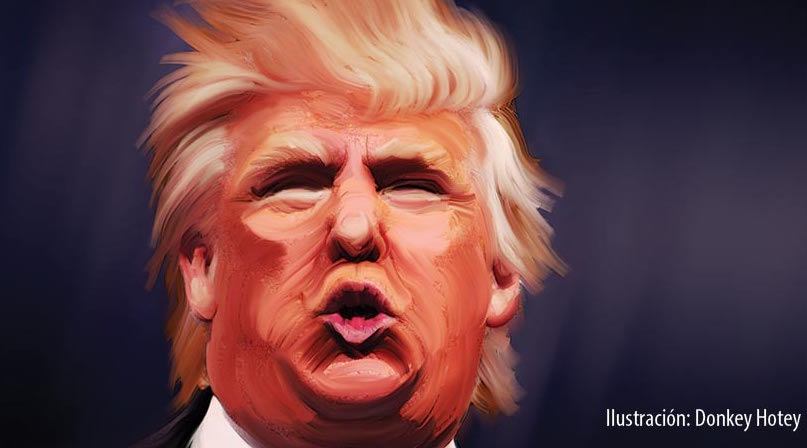The United States’ “Brexit Moment”
The big corporate media that rallied behind Hillary Clinton resorted to the “black swan” metaphor to explain Donald Trump’s disconcerting triumph. But when “black swans” come out in flocks, as they did this year with the Brexit triumph, the US presidential elections, the rise of UKIP, the National Front and other variants of the European extreme right, the “odd bird” theory fails to explain much.
Although there are national particularities and several combined reasons – economic, but also ethnic, religious, gender-related, geographical, cultural and generational – the effective causes of the emergence of this kind of right-wing “populist international” have existed for some time now. They can be found in the conditions of social polarization created by the capitalist crisis of 2008, which had its epicenter in the core countries. And, more in general, in the decades of globalization and neoliberalism that resulted in obscene inequality and created a handful of big winners, corporations and banks, and an exceedingly large mass of losers. Among the latter are, essentially, the middle classes with low or average levels of education, which industrial working-class sectors have also felt a part of, as well as segments of non-globalized capital, microentrepreneurs and small-scale exploiters who feel powerless in the face of forces they cannot dominate and, as expressed by the pro-Brexit slogan, they want to “take back control.” This heterogeneous social conglomerate is what is behind the revolt against the “establishment” and traditional parties, whether conservative, social democrat or liberal, which made up the “extreme center”(1)of the neoliberal consensus, using Tariq Ali’s accurate designation.
In the long US electoral campaign that began with both parties’ primaries, this repudiation of the political caste took on multiple forms: the extremely high levels of unpopularity of both Trump and Hillary, the eruption of the youth on the political scene expressed in Sander’s campaign, the low voter turnout and the almost 7 million votes garnered by third parties, including the Green Party, which presented itself as a left-wing alternative. The number of third-party votes increased three-fold compared to 2012, and was especially concentrated among millennials.
Trump lost the popular vote by a historically unprecedented margin. The difference in favor of Hillary was nearly 3 million votes. The closest precedent is that of George W. Bush, who lost the popular election against Al Gore by 540,000 votes in 2000, although he was designated as President by a Supreme Court ruling that prevented a ballot recount. This lays bare the profoundly anti-democratic nature of the US political system, in which the rural areas are given precedence in the Electoral College. Although it is now merely an anecdote, it shows the extent to which the foundations of the two-party system have deteriorated.
In short, more than the last in a series of unpleasant surprises, Trump’s triumph confirms and deepens the trend towards an organic crisis that has become evident in core countries since the Great Recession of 2008, and may be interpreted as one of those “aberrant phenomena” referred to by Antonio Gramsci, which emerge in intermediate situations when the old cannot go on and it is not yet clear what the new will look like. This shift in US politics announces the beginning of an extraordinary time, a situation full of greater inter-state tensions, trade wars, military conflicts, increased class struggles and bourgeois responses of at least a Caesarist nature.
The Government and the World to Come
The mere fact that a billionaire xenophobe who flirts with protectionism and nationalism was elected president of the biggest world power shows that the neoliberal order dominated by the United States, which after the fall of the Soviet Union predicted the reign of free market and globalization with no alternatives (the failed “end of history”), is being blown up from within.
Neither the allies nor the enemies or competitors of the United States know for certain what to expect come January 20th, when Trump formally becomes the 45th US President and the Republicans take full control of state power.
The establishment, or what Howard Zinn defines as that “uneasy club of business executives, generals and politicos,” which bet almost entirely on the continuity offered by Hillary Clinton, went from initial shock to pragmatism. All political signs indicate that the two-party system seems willing to metabolize the “Trump phenomenon” and downgrade the level of tension from “apocalyptic” to a more modest “presidential transition.”
It is not yet clear that they will achieve this. But it is very likely that governance will require a complex negotiation among the different sectors and interest groups that make up the Republican Party, in which the moderate conservatives have lost their hegemony to the (extreme) racist, sexist, xenophobic and homophobic right.
Perhaps the excitement of returning to the White House and the need to influence the decisions of the next President will lead the GOP to leave behind the #NeverTrump slogan and rally behind the tycoon. In addition to white supremacists and members of the so-called “alt-right,”(2) several names have been mentioned as possible candidates for the next cabinet, such as Newt Gingrich, leader of the “conservative revolution” of 1994, Rudolph Giuliani, the “zero-tolerance” police-like former mayor of the New York City, and Reince Priebus, the Chairman of the Republican National Committee. Retired generals and even moderate conservatives such as Mitt Romney have paraded through the Trump Tower, from where the businessman is commanding the transition and planning his government. Even the neocons, the sector of hawks most refractory to Trump’s leadership and closest to Hillary Clinton with regard to foreign policy, seek to become a part of the new administration. Although their perspectives seem hard to reconcile, there is no wall between the selective isolationism promoted by Trump and the unilateralism practiced by the neocons under both Bush administrations. Both believe that it is necessary to redefine the role of institutions of the “international community” such as the United Nations and NATO, which they see as relative obstacles to the defense of US national interests.
The mainstream is betting on Trump’s presidency staying within the parameters of an innovative Republican administration, à la Ronald Reagan. And there is something to this. In a sense, “Trumpism” can be defined as Reaganomics (lower taxes on the rich, deregulation and higher interest rates) plus protectionist policies. Domestically, reindustrialization is a pipe dream, but Trump seems to be determined to make part of US capital operating abroad return to the country. His main bargaining chips are the negotiation of a lower corporate tax rate, from 35 to 15%, deregulation and other cuts, such as the repeal of Obamacare, which would release businessmen from having to pay healthcare costs. For now, his most concrete proposal is a public works plan, which seems insufficient to offset the loss of benefits from relocation to areas with lower wages.
No one can say for certain how “America will be made great again.” But what can already be assumed is that a certain percentage of Trump’s campaign slogans will prove not to be mere electoral demagoguery. Several analysts believe that this sharp turn in US politics has the potential to produce geopolitical and economic changes equivalent to the fall of the Berlin Wall in 1989, although in the opposite direction.
Trump’s foreign policy will clearly constitute a significant shift with respect to that of Obama, who implemented a “centrist” policy to reconstitute the global leadership of the US that favored diplomacy in order to reduce direct military exposure and leave behind the failed militarist and unilateral strategy implemented by Bush and the neocons, which led to the wars and occupations of Iraq and Afghanistan.
In his official messages on what the first 100 days of his administration could hold, the President-elect announced measures that had already been proposed: withdrawing the United States from the Trans-Pacific Partnership and renegotiating the terms of NAFTA with Mexico and perhaps with the WTO as well, with the threat of walking away from agreements if they are not more favorable to the United States; seeking Russia’s cooperation for combating ISIS and finding a solution to the crisis in Syria, which implies keeping Assad in power; re-negotiating with the US’s allies a greater contribution to NATO funding and establishing new conditions for maintaining US bases in other countries, such as Japan and South Korea.
In the Middle East, his policy seems to be to reinforce traditional partnerships, such as the one between the United States and Israel and the Gulf monarchies, which could lead to the repudiation or at least reconsideration of the agreement with Iran.
Relations with Russia and China are still subject to speculation. It seems unlikely that Trump will be able to change two decades of US policy, which has been marked by hostility towards Russia. This strategy is ultimately based on a long-term fundamental interest, which is the reduction of Russia to semicolonial status. But Trump’s friendly statements towards Putin are already causing concern among the Baltic and Eastern European countries that have been incorporated into NATO and are on the front line of the West’s missile deployment against Russia.
Some believe Trump will take a harder line, but only at the negotiating table, and others emphasize that a more venturesome approach cannot be ruled out. All options are on the table. But in the context of various forms of rising nationalism, the prospect of trade wars or at least fierce competition, and the persistent decline of US hegemony, any unilateral action by the United States could lead to a crisis of unpredictable proportions. This is what the world seems to be preparing for.
Bonapartism, Fascism and the Debate on the Left
The specific social and political nature of the Trump phenomenon is still under debate. In analyzing the Trump voters, what garnered the most attention was the unexpected percentage of women given the manifest misogyny of the President-elect, and especially the vote of sectors of the old white industrial working class: the “Trumpenproletariat,” characterized by their political backwardness and a certain racist and xenophobic sensibility. This phenomenon should be analyzed further.
It is a fact that in the swing states, a large majority of blue collar workers were drawn to Trump’s demagoguery, and Trump campaigned in the Rust Belt as never before, with the promise of bringing back lost jobs. And against all forecasts, his vote extended beyond the traditional Republican electorate. But the core of Trump’s social base are essentially the small businessmen and self-employed workers who, unlike big corporations, do not benefit from free trade deals and imports and, therefore, are attracted by rhetoric that combines economic protectionism with the traditional Republican-Reaganist program of tax reduction and the elimination of state regulations (including the healthcare system, which they are obligated to pay for in part under current
law). As a Jacobin article argued, rather than a revolt of the working class, Trump represents the “revenge of Joe the plumber,” in reference to the conservative activist that confronted Obama in Ohio during the 2008 primaries and became the symbol of the petty bourgeoisie’s frustration.
In spite of having obtained a greater percentage of the union household vote than Reagan, Trump actively combated unionization as a businessman and has a clear anti-union policy, typical of the Republican Party, which includes strengthening “right-to-work” laws and repealing the scarce regulations put in place during the Obama era, which virtually means prohibiting unions in the private sector and escalating the attack on public workers’ unions. (3)
The emergence of Trump has sparked an extensive strategic debate among the left. Various liberal, left-wing and social democrat intellectuals have put forward their interpretations.
J. Habermas defines Trump as part of a populist surge, as a kind of breakdown of political rationality. According to Polish sociologist Z. Bauman, we are witnessing the emergence of a “decisionist leader,” using Carl Schmitt’s classic definition of sovereign power that so accurately explained the first stages of Nazism. In Alain Badiou’s view, it is a kind of “democratic fascism,” a contradiction in terms that the French philosopher resolves in his own way, affirming that it is within the democratic system and does not confront the enemies confronted by fascism in the 30s: the workers’ movement and communist parties. In addition, abundant references are made to the 18th Brumaire as well as analogies with the German elections of 1933 in measuring the reactionary potential of Trump’s triumph.
Strictly speaking, Trump’s win expresses a shift towards a more Bonapartist and authoritarian regime rather than the immediate emergence of fascism, but undoubtedly contains fascistoid elements, such as the KKK and supremacist groups of the “alt-right,” within a context in which there is already a de facto latent civil war against the African-American population.
As with Brexit, a minority of left parties and progressive intellectuals emphasize the fact that there is ultimately a silver lining to Trump’s triumph in that it may destabilize the ruling class, and that it crudely expresses the despotic nature of capitalist power. These sectors tend to downplay the fact that significant sectors of the proletariat opted for a “savior,” a racist and xenophobic multimillionaire who promises to restore the power of US imperialism.
Trump’s administration will be one of the right-wing of the bourgeoisie. It will not bring back workers’ jobs or wages and will launch an attack on democratic gains, such as the right to abortion. His triumph has already emboldened rancid groups of the extreme right.
However, it would be wrong to state that the only phenomenon is a consistent and one-directional turn to the right. There is also the emergence of a certain neo-reformism which, as shown by Sander’s subordination to the Democratic Party, is powerless in the face of the rise of the extreme right.
The most promising phenomenon is the process of mobilizations that began on the very night of Trump’s victory. Tens of thousands of young people, workers, students and women took to the streets or occupied college campuses to say that they will not allow the deportation of undocumented immigrants and that they will resist. The working class has still not recovered from its defeat in the Reagan era, but in the past few years new forms of struggle and organization have emerged, such as the Black Lives Matter movement, the fight for 15 and the strikes in fast food restaurants and large supermarket chains, not to mention the anti-war movement, Occupy Wall Street and, before that, the anti-globalization movement that erupted in Seattle in 1999.
Trump represents the danger of a divide between the working class and its allies among African-American and immigrant minorities and women. This is why it is essential to build a “third party,” which must be a revolutionary party of the left and working class with a program to unify the forces of the exploited and oppressed, both within and outside of the United States, against capital. The clock is ticking.
Tariq Ali, “The Extreme Centre,” Verso Books, 2015. In a similar sense, Peter Mair made a profound analysis of the crisis of the traditional parties and capitalist democracy more in general as of the fall of the Berlin Wall and its relationship with the emergence of “anti-politics.” See: “Ruling the Void? The Hollowing of Western Democracy,” NLR 42, 2006.
The so-called “alt-right” (alternative right) is a lax and heterogeneous conglomerate of groups and individuals of the extreme right who defend “white identity” and “Western civilization” and are opposed to the traditional conservative establishment. Steve Bannon, appointed by Trump as his chief strategist, is accused of belonging to this group.
R. Verbruggen, “Trump and the Unions,” The American Conservative, November 20, 2016.
This article was originally published in Ideas de Izquierda
Translated by Marisela Trevin











